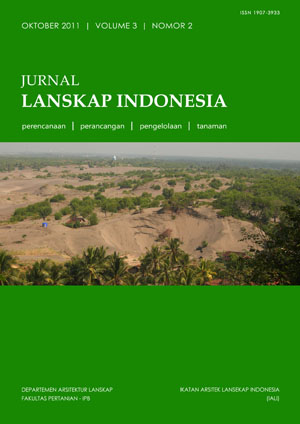STUDI EVALUASI TAMAN KOTA SEBAGAI TAMAN TERAPEUTIK STUDI KASUS: TAMAN CILAKI ATAS, KOTA BANDUNG
Abstract
Urban park have some functions. There are ecology, aesthetics, and social functions. Many parks in Indonesia still have not been utilized as a health environment function. Therefore, it is important to identify potency of potential an existing condition of urban park as a therapeutic park. The objective of study is to evaluate the potency of Cilaki Urban Park, Bandung City, West Java as therapeutic park. The study was started with inventoryand analysis of biophysics, site quality, spatial, site element, user and their activities. Key Performance Index (KPI) method was used to evaluate an existing condition of the park based on modified therapeutic design criteria proposed by some Landscape Architects. Questionnaire was used to confirm
some respondent’s expectations about urban and therapeutic function, and then, the direct observation data used as a verification user’s activities. The result showed that the KPI’s value was 0.61 (scale 0-1), so this urban park has some potentials as a therapeutic urban park. The last result of this study is recommendations based on evaluation among KPI’s value, user’s confirm and surveyor’s verification.
Downloads
This journal permits and encourages authors to post items submitted to the journal on personal websites or institutional repositories both prior to and after publication, while providing bibliographic details that credit, if applicable, its publication in this journal. However, after the article is submitted and published in this journal, it is fully copyrighted by the Jurnal Lanskap Indonesia or JLI. If excerpts from other copyrighted works are included, the author must obtain written permission from the copyright owner and give credit to the source in the article. Then, the writer or reader is allowed to copy, share, and redistribute articles/material in any form. But it must still include the appropriate source and credit because the article in this journal is licensed by Creative Commons Attribution 4.0 International License (CC BY 4.0).
I. Proposed Policy for Journals That Offer Open Access
Authors who publish with this journal agree to the following terms:
- Authors retain copyright and grant the journal right of first publication with the work simultaneously licensed under a Creative Commons Attribution License that allows others to share the work with an acknowledgement of the work's authorship and initial publication in this journal.
- Authors are able to enter into separate, additional contractual arrangements for the non-exclusive distribution of the journal's published version of the work (e.g., post it to an institutional repository or publish it in a book), with an acknowledgement of its initial publication in this journal.
- Authors are permitted and encouraged to post their work online (e.g., in institutional repositories or on their website) prior to and during the submission process, as it can lead to productive exchanges, as well as earlier and greater citation of published work (See The Effect of Open Access).
II. Proposed Policy for Journals That Offer Delayed Open Access
Authors who publish with this journal agree to the following terms:
- Authors retain copyright and grant the journal right of first publication, with the work after publication simultaneously licensed under a Creative Commons Attribution License that allows others to share the work with an acknowledgement of the work's authorship and initial publication in this journal.
- Authors are able to enter into separate, additional contractual arrangements for the non-exclusive distribution of the journal's published version of the work (e.g., post it to an institutional repository or publish it in a book), with an acknowledgement of its initial publication in this journal.
- Authors are permitted and encouraged to post their work online (e.g., in institutional repositories or on their website) prior to and during the submission process, as it can lead to productive exchanges, as well as earlier and greater citation of published work (See The Effect of Open Access).



























